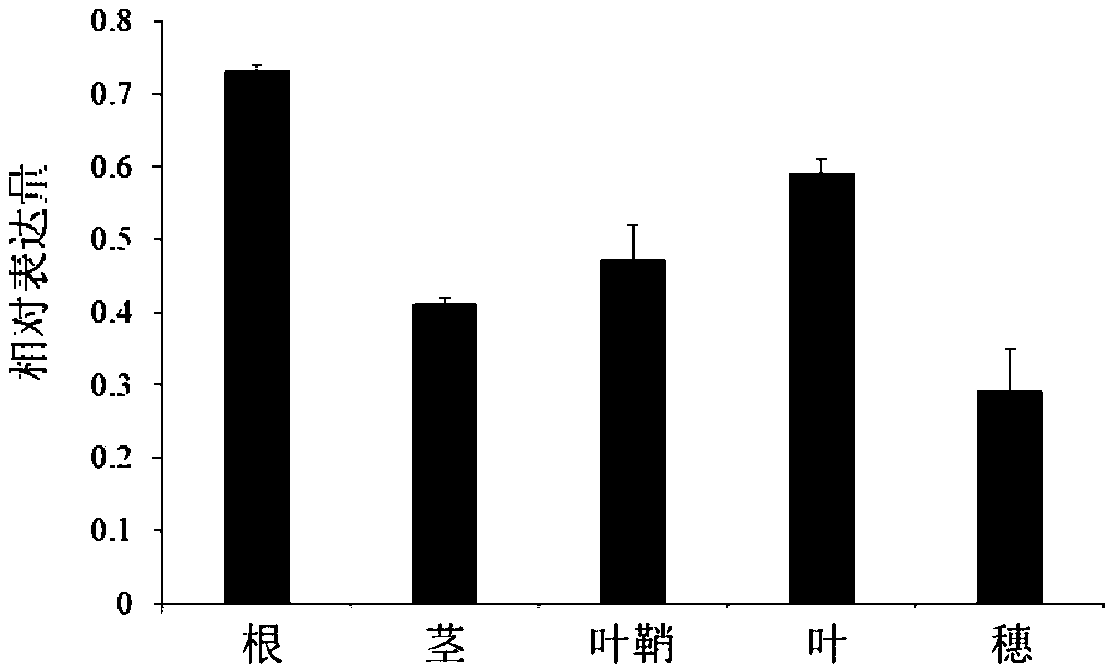Paddy rice NRT 1.1A gene and application of encoded protein of paddy rice NRT 1.1A gene to improve plant yield in breeding
A technology for transgenic plants and yield, applied in plant peptides, genetic engineering, recombinant DNA technology, etc., can solve problems such as environmental degradation, excessive use of nitrogen fertilizer, and low nitrogen use efficiency
- Summary
- Abstract
- Description
- Claims
- Application Information
AI Technical Summary
Problems solved by technology
Method used
Image
Examples
Embodiment 1
[0077] Example 1, Analysis of the expression of NRT1.1A in rice tissues
[0078] The NRT1.1A gene involved in this example is derived from rice (Oryza.sativa L.), its genome sequence is shown in sequence 2 in the sequence listing, sequence 2 consists of 8143 nucleotides, and its cDNA sequence is the sequence listing Middle sequence 3, sequence 3 consists of 1812 nucleotides. Sequence 2 and Sequence 3 encode the protein (NRT1.1A protein) shown in Sequence 1 in the Sequence Listing, and Sequence 1 consists of 603 amino acid residues.
[0079] Total RNA was extracted from the root, stem, leaf sheath, leaf and ear of rice variety Dongjin and cDNA was obtained by reverse transcription. Furthermore, using the obtained cDNA as a template, real-time quantitative fluorescent PCR was carried out for the NRT1.1A gene to detect the expression level of the NRT1.1A gene at the transcription level in various tissues of rice. The experiment was repeated 3 times, and the results were averaged....
Embodiment 2
[0088] Example 2. Verification of NRT1.1A's in vitro nitrate transport activity
[0089] The NRT1.1A gene involved in this example is derived from rice (Oryza.sativa L.), its genome sequence is shown in sequence 2 in the sequence listing, sequence 2 consists of 8143 nucleotides, and its cDNA sequence is the sequence listing Middle sequence 3, sequence 3 consists of 1812 nucleotides. Sequence 2 and Sequence 3 encode the protein (NRT1.1A protein) shown in Sequence 1 in the Sequence Listing, and Sequence 1 consists of 603 amino acid residues.
[0090] 1. Xenopus laevis recombinant expression vector pCS2 + / Build of NRT1.1A
[0091] The total RNA of japonica rice variety Dongjin was extracted and reverse transcribed into cDNA. The obtained cDNA was used as a template, and the NRT1.1A cDNA was amplified by PCR using the following primer sequences. The two ends of the primers used for amplification were respectively introduced into the recognition sites of the restriction endonu...
Embodiment 3
[0101] Example 3. Obtainment and functional verification of rice nrt1.1a mutant
[0102] The NRT1.1A gene involved in this example is derived from rice (Oryza.sativa L.), its genome sequence is shown in sequence 2 in the sequence listing, sequence 2 consists of 8143 nucleotides, and its cDNA sequence is the sequence listing Middle sequence 3, sequence 3 consists of 1812 nucleotides. Sequence 2 and Sequence 3 encode the protein (NRT1.1A protein) shown in Sequence 1 in the Sequence Listing, and Sequence 1 consists of 603 amino acid residues.
[0103] 1. Obtaining and identification of rice nrt1.1a mutant
[0104] Rice nrt1.1a mutant: from Korean Rice Mutant Bank (Crop Biotech Institute, KyungHee University, Republic of Korea, http: / / www.postech.ac.kr / life / pfg / risd), the order URL is http: / / signal.salk.edu / cgi-bin / RiceGE5, the corresponding number of the rice nrt1.1a mutant is PFG_1E-00433.L. The specific construction method is described in the article "Jakyung Yi, Gynheung A...
PUM
 Login to View More
Login to View More Abstract
Description
Claims
Application Information
 Login to View More
Login to View More - Generate Ideas
- Intellectual Property
- Life Sciences
- Materials
- Tech Scout
- Unparalleled Data Quality
- Higher Quality Content
- 60% Fewer Hallucinations
Browse by: Latest US Patents, China's latest patents, Technical Efficacy Thesaurus, Application Domain, Technology Topic, Popular Technical Reports.
© 2025 PatSnap. All rights reserved.Legal|Privacy policy|Modern Slavery Act Transparency Statement|Sitemap|About US| Contact US: help@patsnap.com



